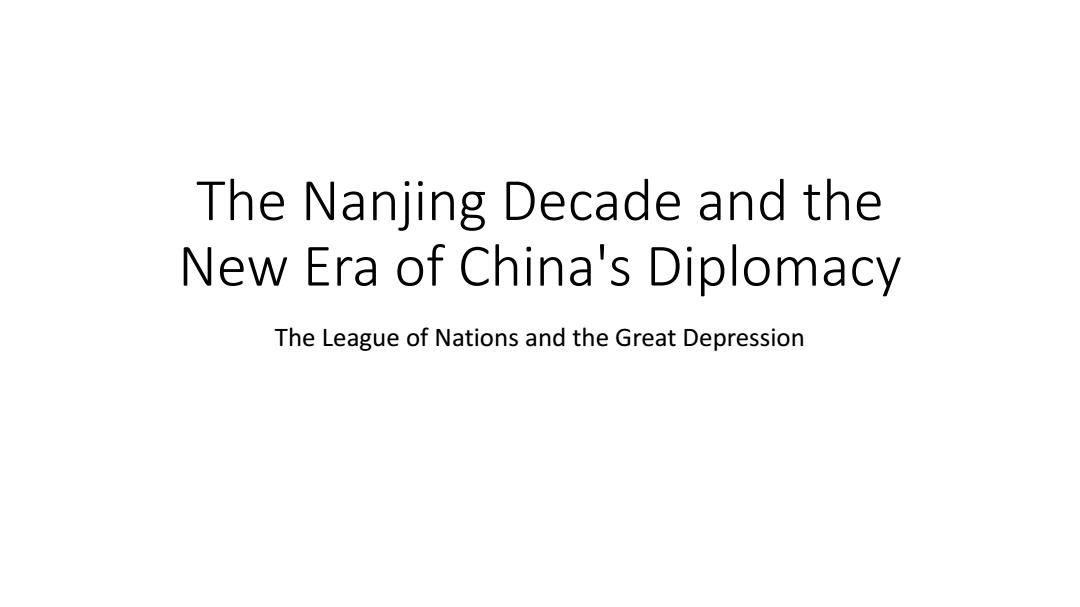
The Nanjing Decade and the New Era of China's diplomacy The League of Nations and the Great Depression
The Nanjing Decade and the New Era of China's Diplomacy The League of Nations and the Great Depression
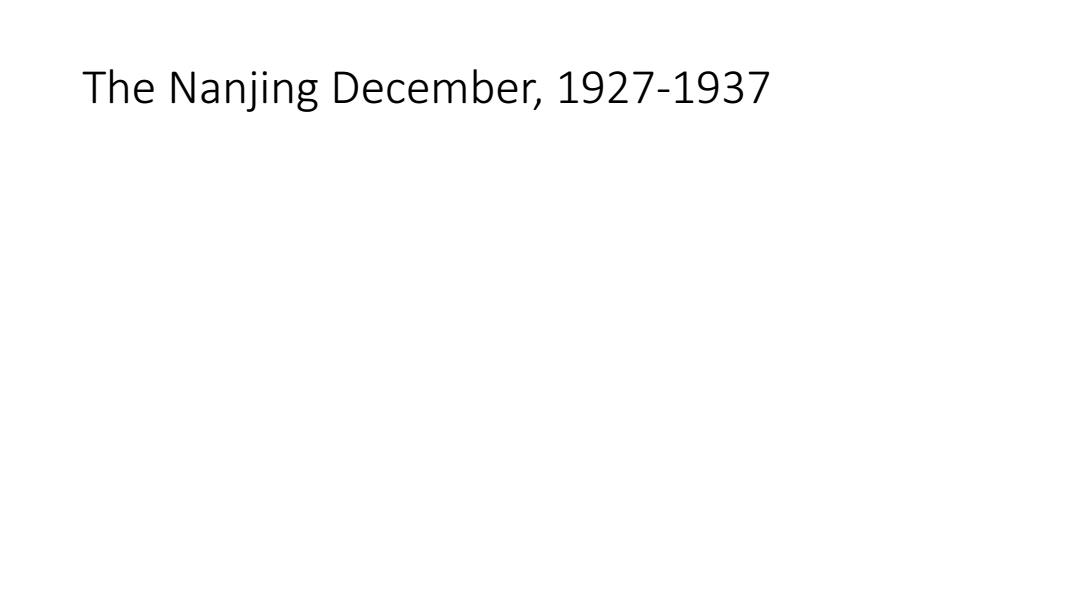
The Nanjing December,1927-1937
The Nanjing December, 1927-1937
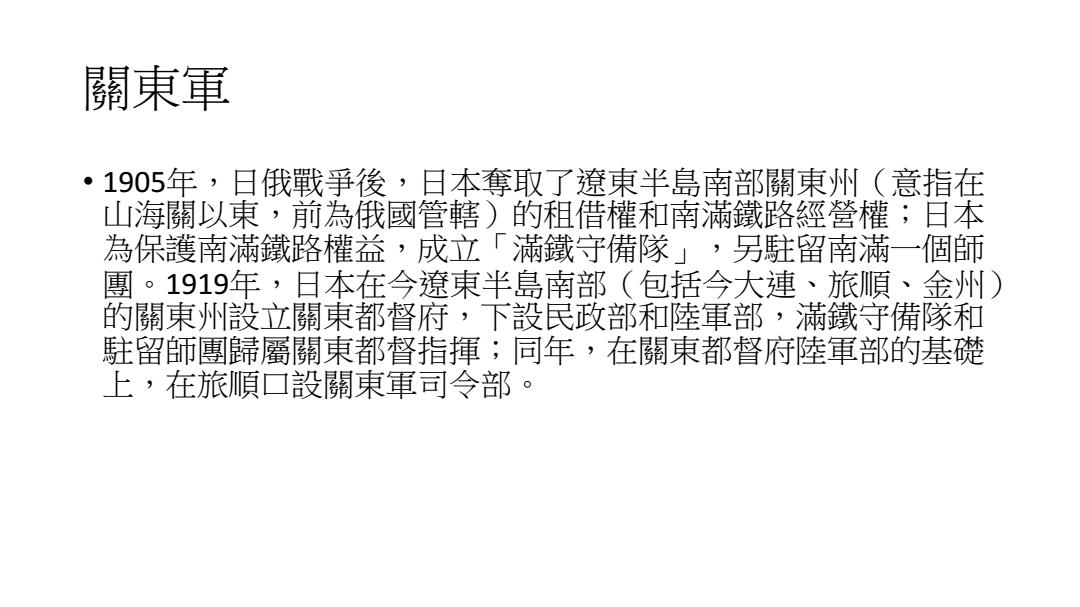
關東軍 ·1905年,日俄戰爭後,日本奪取了遼東半島南部關東州(意指在 山海關以東,前為俄國管轄)的租借權和南滿鐵路經營權;日本 為保護南滿鐵路權益,成立「滿鐵守備隊」,另駐留南滿一個師 團。1919年,日本在今遼東半島南部(包括今大連、旅順、金州) 的關東州設立關東都督府,下設民政部和陸軍部,滿鐵守備隊和 駐留師團歸屬關東都督指揮氵同年,在關東都督府陸軍部的基礎 上,在旅順口設關東軍司令部
關東軍 • 1905年,日俄戰爭後,日本奪取了遼東半島南部關東州(意指在 山海關以東,前為俄國管轄)的租借權和南滿鐵路經營權;日本 為保護南滿鐵路權益,成立「滿鐵守備隊」,另駐留南滿一個師 團。1919年,日本在今遼東半島南部(包括今大連、旅順、金州) 的關東州設立關東都督府,下設民政部和陸軍部,滿鐵守備隊和 駐留師團歸屬關東都督指揮;同年,在關東都督府陸軍部的基礎 上,在旅順口設關東軍司令部

The Great Depression and Japan
The Great Depression and Japan
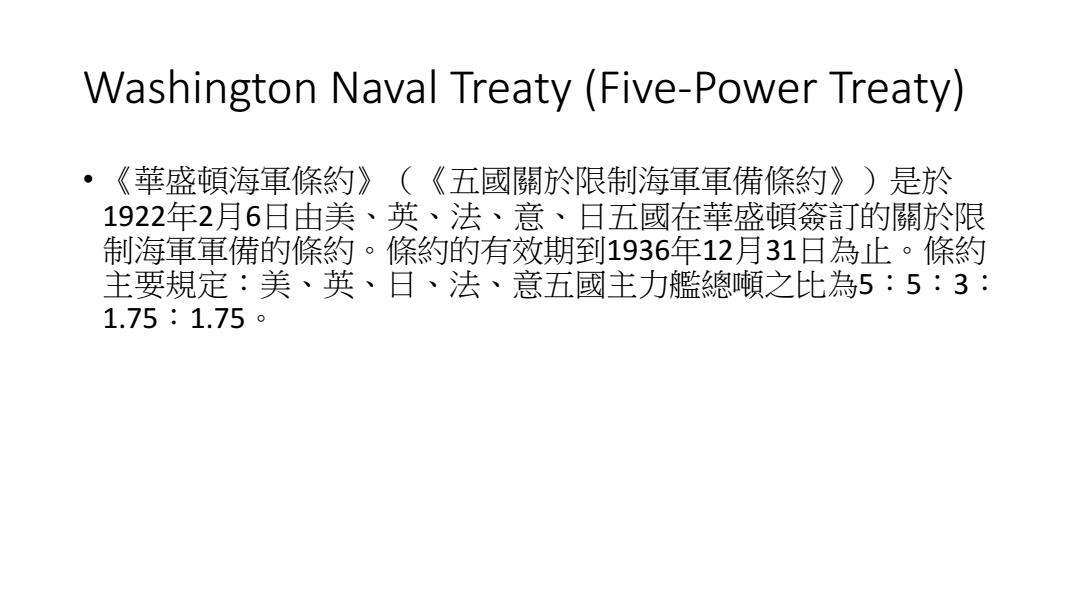
Washington Naval Treaty(Five-Power Treaty) ·《華盛頓海軍條約》(《五國關於限制海軍軍備條約》)是於 1922年2月6日由美、英、法、意、日五國在華盛頓簽钉的關於限 制海軍軍備的條約。條約的有效期到1936年12月31日為止。條約 主要規定:美、英、日、法、意五國主力艦總噸之比為5:5:3: 1.75:1.75
Washington Naval Treaty (Five-Power Treaty) • 《華盛頓海軍條約》(《五國關於限制海軍軍備條約》)是於 1922年2月6日由美、英、法、意、日五國在華盛頓簽訂的關於限 制海軍軍備的條約。條約的有效期到1936年12月31日為止。條約 主要規定:美、英、日、法、意五國主力艦總噸之比為5:5:3: 1.75:1.75
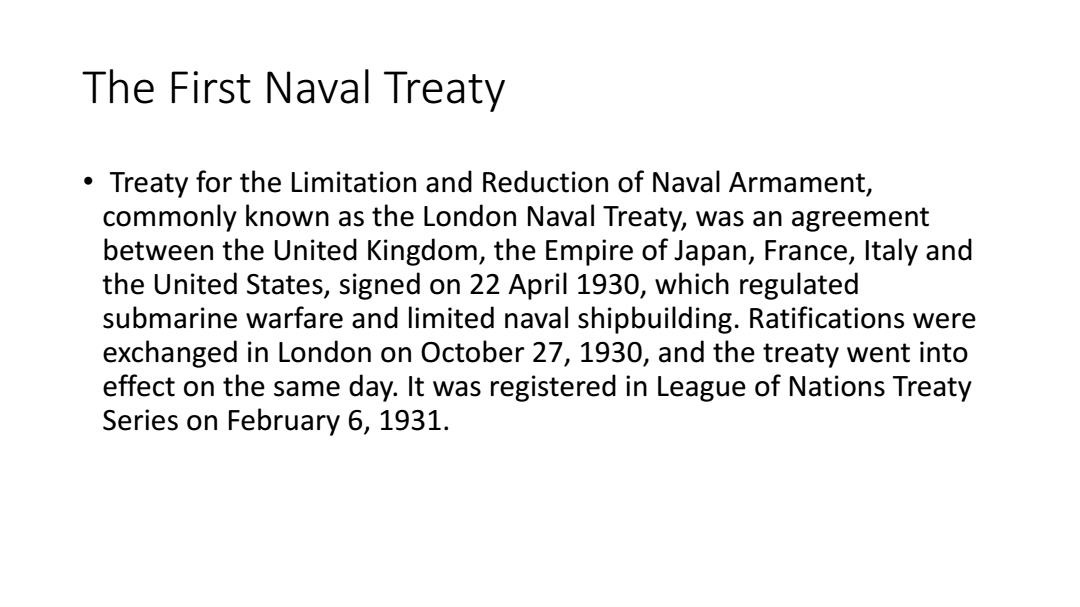
The First naval Treaty Treaty for the Limitation and Reduction of Naval Armament, commonly known as the London Naval Treaty,was an agreement between the United Kingdom,the Empire of Japan,France,Italy and the United States,signed on 22 April 1930,which regulated submarine warfare and limited naval shipbuilding.Ratifications were exchanged in London on October 27,1930,and the treaty went into effect on the same day.It was registered in League of Nations Treaty Series on February 6,1931
The First Naval Treaty • Treaty for the Limitation and Reduction of Naval Armament, commonly known as the London Naval Treaty, was an agreement between the United Kingdom, the Empire of Japan, France, Italy and the United States, signed on 22 April 1930, which regulated submarine warfare and limited naval shipbuilding. Ratifications were exchanged in London on October 27, 1930, and the treaty went into effect on the same day. It was registered in League of Nations Treaty Series on February 6, 1931
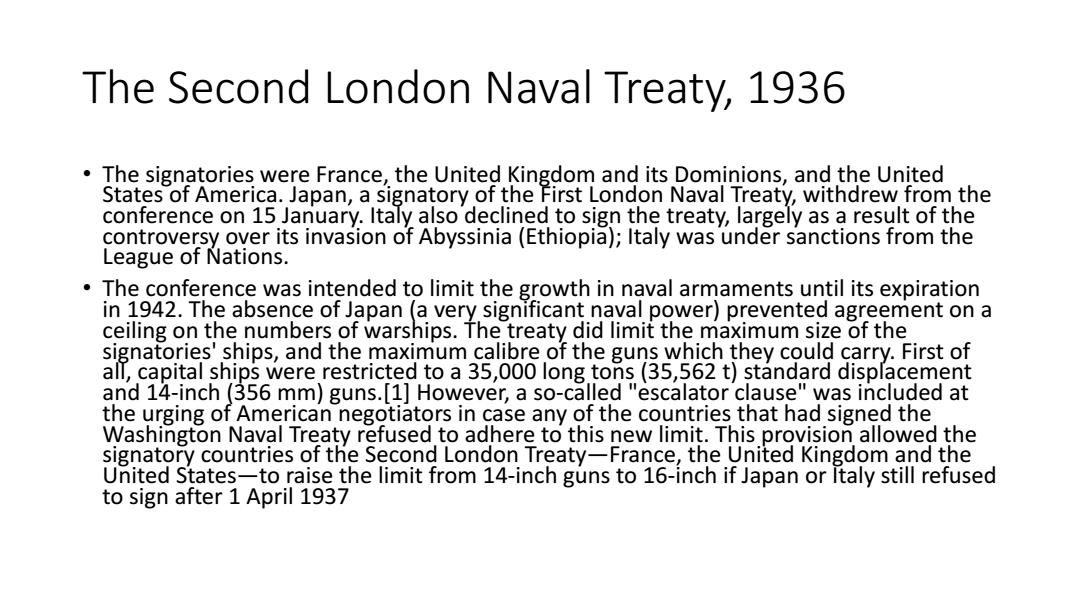
The Second London Naval Treaty,1936 The signatories were France,the United Kingdom and its Dominions,and the United States of America.Japan,a signatory of the First London Naval Treaty,withdrew from the conference on 15 January.Italy also declined to sign the treaty,largely as a result of the controversy over its invasion of Abyssinia(Ethiopia);Italy was under sanctions from the League of Nations. The conference was intended to limit the growth in naval armaments until its expiration in 1942.The absence of Japan(a very significant naval power)prevented agreement on a ceiling on the numbers of warships.The treaty did limit the maximum size of the signatories'ships,and the maximum calibre of the guns which they could carry.First of all,capital ships were restricted to a 35,000 long tons(35,562 t)standard displacement and 14-inch (356 mm)guns.[1]However,a so-called "escalator clause"was included at the urging of American negotiators in case any of the countries that had signed the Washington Naval Treaty refused to adhere to this new limit.This provision allowed the signatory countries of the Second London Treaty-France,the United Kingdom and the United States-to raise the limit from 14-inch guns to 16-inch if Japan or Italy still refused to sign after 1 April 1937
The Second London Naval Treaty, 1936 • The signatories were France, the United Kingdom and its Dominions, and the United States of America. Japan, a signatory of the First London Naval Treaty, withdrew from the conference on 15 January. Italy also declined to sign the treaty, largely as a result of the controversy over its invasion of Abyssinia (Ethiopia); Italy was under sanctions from the League of Nations. • The conference was intended to limit the growth in naval armaments until its expiration in 1942. The absence of Japan (a very significant naval power) prevented agreement on a ceiling on the numbers of warships. The treaty did limit the maximum size of the signatories' ships, and the maximum calibre of the guns which they could carry. First of all, capital ships were restricted to a 35,000 long tons (35,562 t) standard displacement and 14-inch (356 mm) guns.[1] However, a so-called "escalator clause" was included at the urging of American negotiators in case any of the countries that had signed the Washington Naval Treaty refused to adhere to this new limit. This provision allowed the signatory countries of the Second London Treaty—France, the United Kingdom and the United States—to raise the limit from 14-inch guns to 16-inch if Japan or Italy still refused to sign after 1 April 1937

Inukai Tsuyoshi(犬養毅)Administration ·1931年12月,立憲民政黨的若覜禮次郎内閣倒台,犬養作為反對 黨總裁被授命組閣,出任日本第29任內閣總理大臣。時值全球範 圍的經濟大蕭條,軍隊又武力侵占了中國東北省份,日本内外形 勢十分複雜、混亂。他任命高橋是清為大藏大臣(即財政部長), 禁止黄金輸出,以積極的財政政策對抗經濟危機。但因削减軍費 而得罪軍部,進而為自己日後被軍人刺殺埋下誘因。又命自己的 女婿芳澤謙吉為外相,在容易受軍部影響的外交政策方面也確立 了領導權
Inukai Tsuyoshi (犬養毅) Administration • 1931年12月,立憲民政黨的若槻禮次郎內閣倒台,犬養作為反對 黨總裁被授命組閣,出任日本第29任內閣總理大臣。時值全球範 圍的經濟大蕭條,軍隊又武力侵占了中國東北省份,日本內外形 勢十分複雜、混亂。他任命高橋是清為大藏大臣(即財政部長), 禁止黃金輸出,以積極的財政政策對抗經濟危機。但因削減軍費 而得罪軍部,進而為自己日後被軍人刺殺埋下誘因。又命自己的 女婿芳澤謙吉為外相,在容易受軍部影響的外交政策方面也確立 了領導權
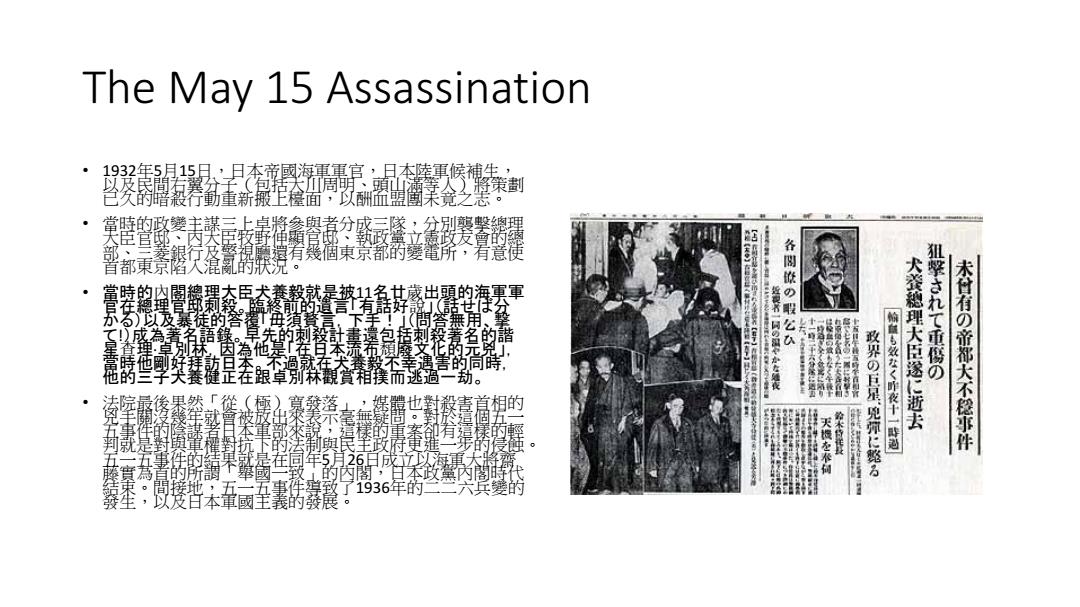
The may 15 Assassination 1932年5月15日,,日本帝國海更重官,日本陸重候補生, 以及民間右翼公 (包括大周明頭山满等人)將策劃 色父的殺荞勤重新瘢上穆面·玫酬盗盟围某凳之恙。 當時的政變主謀三上卓將参與者分成三隧,分别襲擊總理 臣宫塑,因大 臣牧霸管:软政立玫爱查的 部 視廳擅有幾個東京都的變電所,肴意使 都秉奈落大蘭的采說。 當時的肉闔貔理太臣犬養教就是被11名甘藏出頭的海票軍 餐前的遺言「有話好說」(話甘 各關能少戰 9 苏石)以及暴徒的答覆T母須贅言 (問答無用 之坚與享别猷餐 草先的刺被計遗包猛刺 者 名 諧 环, E 素會有帝 的元 他好 的同時, 近费着一同办衣 一十六分 整九工重假 大發總理大臣途仁逝去 煤體也對殺壹 首相的 五 本郭與得毕战青事雅月蕖 政界巨星兒师仁整3 愉鱼b效社<昨夜十一時過 大不糯事件 的 第果露藏在年成中 天惯奉 本政黨伪閣時 0 接地五一五事件導致 1936年的 發 及甘本童國主羲的展
The May 15 Assassination • 1932年5月15日,日本帝國海軍軍官,日本陸軍候補生, 以及民間右翼分子(包括大川周明、頭山滿等人)將策劃 已久的暗殺行動重新搬上檯面,以酬血盟團未竟之志。 • 當時的政變主謀三上卓將參與者分成三隊,分別襲擊總理 大臣官邸、內大臣牧野伸顯官邸、執政黨立憲政友會的總 部、三菱銀行及警視廳還有幾個東京都的變電所,有意使 首都東京陷入混亂的狀況。 • 當時的內閣總理大臣犬養毅就是被11名廿歲出頭的海軍軍 官在總理官邸刺殺。臨終前的遺言「有話好說」(話せば分 かる)以及暴徒的答覆「毋須贅言,下手!」(問答無用、撃 て!)成為著名語錄。早先的刺殺計畫還包括刺殺著名的諧 星查理·卓別林,因為他是「在日本流布頹廢文化的元兇」, 當時他剛好拜訪日本。不過就在犬養毅不幸遇害的同時, 他的三子犬養健正在跟卓別林觀賞相撲而逃過一劫。 • 法院最後果然「從(極)寬發落」,媒體也對殺害首相的 兇手關沒幾年就會被放出來表示毫無疑問。對於這個五一 五事件的陰謀者日本軍部來說,這樣的重案卻有這樣的輕 判就是對與軍權對抗下的法制與民主政府更進一步的侵蝕。 五一五事件的結果就是在同年5月26日成立以海軍大將齋 藤實為首的所謂「舉國一致」的內閣,日本政黨內閣時代 結束。間接地,五一五事件導致了1936年的二二六兵變的 發生,以及日本軍國主義的發展
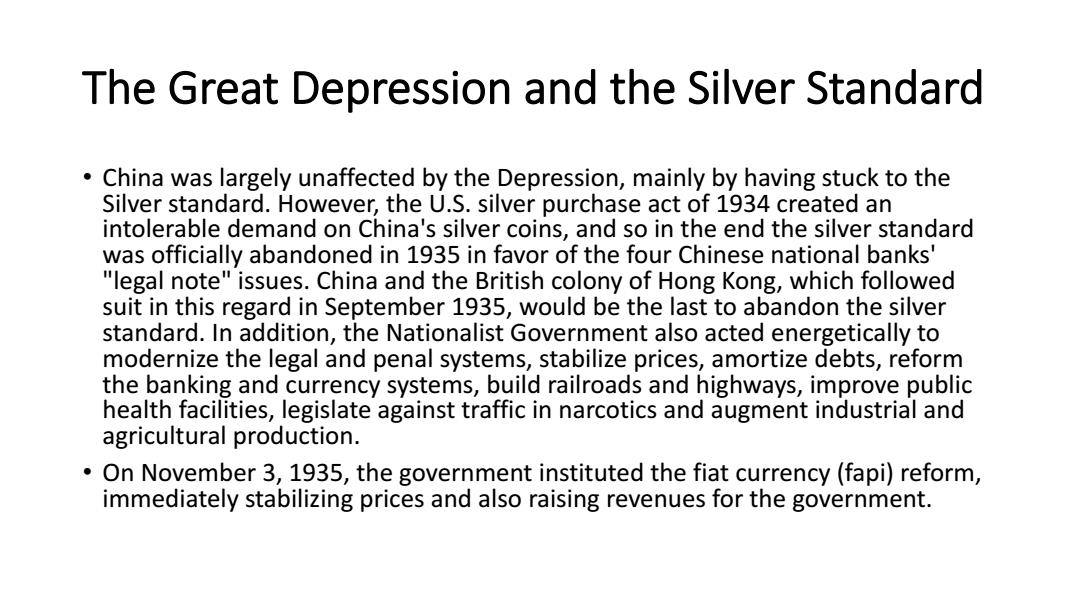
The Great Depression and the Silver Standard China was largely unaffected by the Depression,mainly by having stuck to the Silver standard.However,the U.S.silver purchase act of 1934 created an intolerable demand on China's silver coins,and so in the end the silver standard was officially abandoned in 1935 in favor of the four Chinese national banks "legal note"issues.China and the British colony of Hong Kong,which followed suit in this regard in September 1935,would be the last to abandon the silver standard.In addition,the Nationalist Government also acted energetically to modernize the legal and penal systems,stabilize prices,amortize debts,reform the banking and currency systems,build railroads and highways,improve public health facilities,legislate against traffic in narcotics and augment industrial and agricultural production. On November 3,1935,the government instituted the fiat currency(fapi)reform, immediately stabilizing prices and also raising revenues for the government
The Great Depression and the Silver Standard • China was largely unaffected by the Depression, mainly by having stuck to the Silver standard. However, the U.S. silver purchase act of 1934 created an intolerable demand on China's silver coins, and so in the end the silver standard was officially abandoned in 1935 in favor of the four Chinese national banks' "legal note" issues. China and the British colony of Hong Kong, which followed suit in this regard in September 1935, would be the last to abandon the silver standard. In addition, the Nationalist Government also acted energetically to modernize the legal and penal systems, stabilize prices, amortize debts, reform the banking and currency systems, build railroads and highways, improve public health facilities, legislate against traffic in narcotics and augment industrial and agricultural production. • On November 3, 1935, the government instituted the fiat currency (fapi) reform, immediately stabilizing prices and also raising revenues for the government